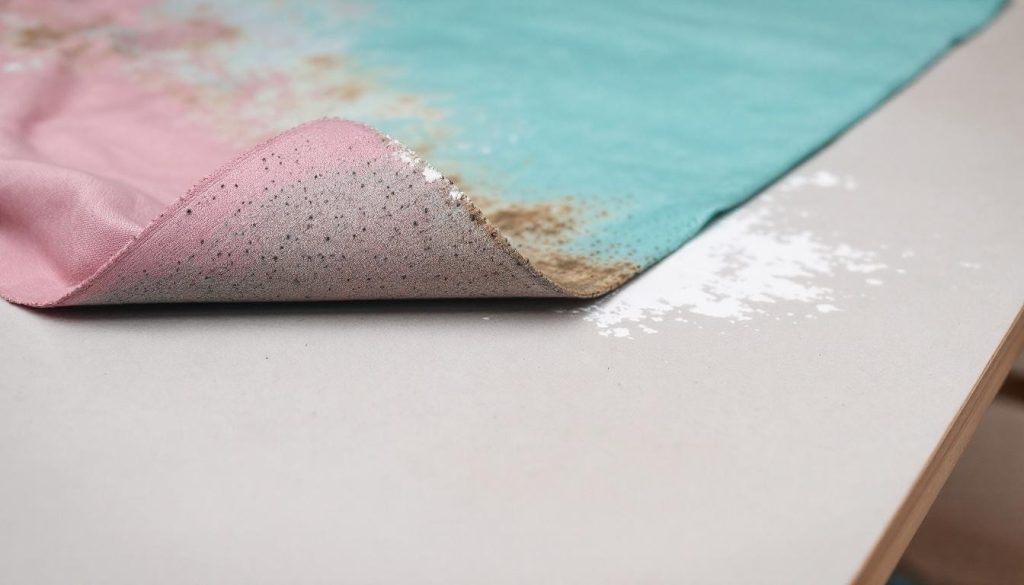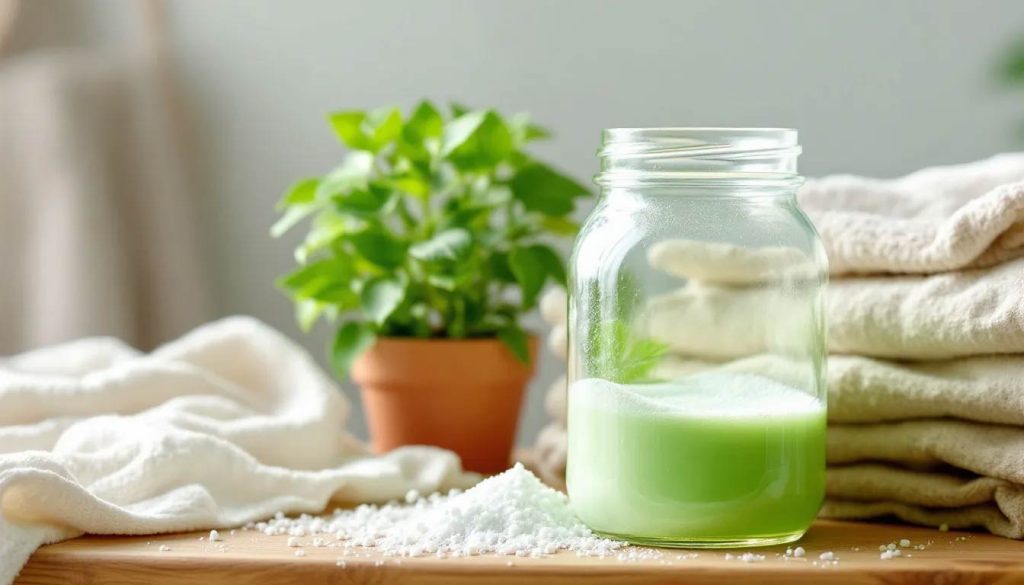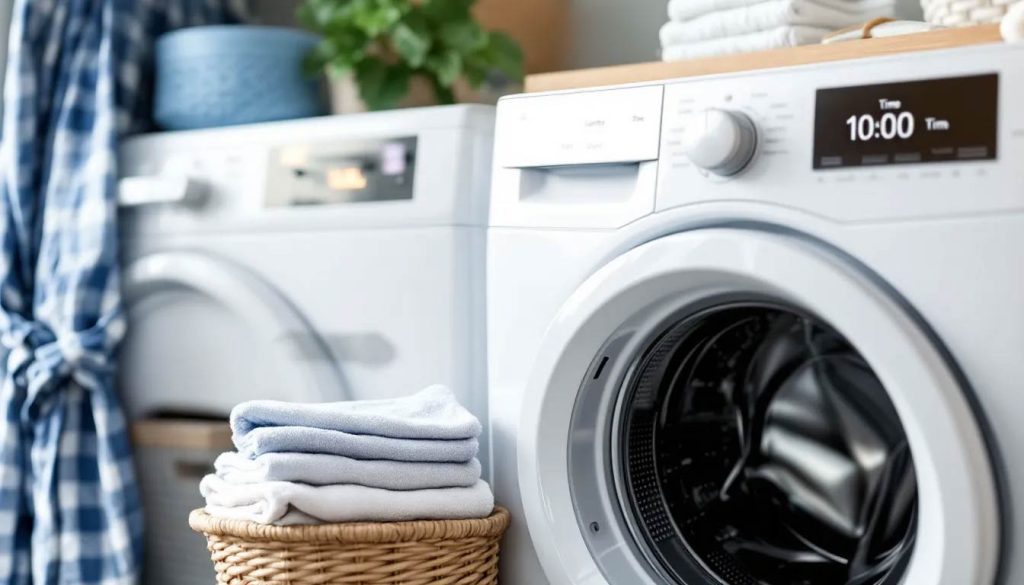Mold and mildew can wreak havoc on fabrics, turning cherished items into health hazards. At Oasis Laundry, we’ve seen firsthand the damage these fungi can cause to textiles.
Swift action and proper mold remediation techniques are essential to rescue affected fabrics and prevent future growth. This guide will equip you with the knowledge and tools to combat mold and mildew on your textiles effectively.
What Causes Mold and Mildew on Fabrics?
The Perfect Storm for Mold Growth
Moisture stands as the primary culprit behind mold and mildew on fabrics. Clothes left in washing machines, damp towels tossed in hampers, or items stored in humid basements create ideal conditions for fungal growth. The Environmental Protection Agency reports that mold can start growing on damp surfaces within 24-48 hours if wet or damp materials are not dried.
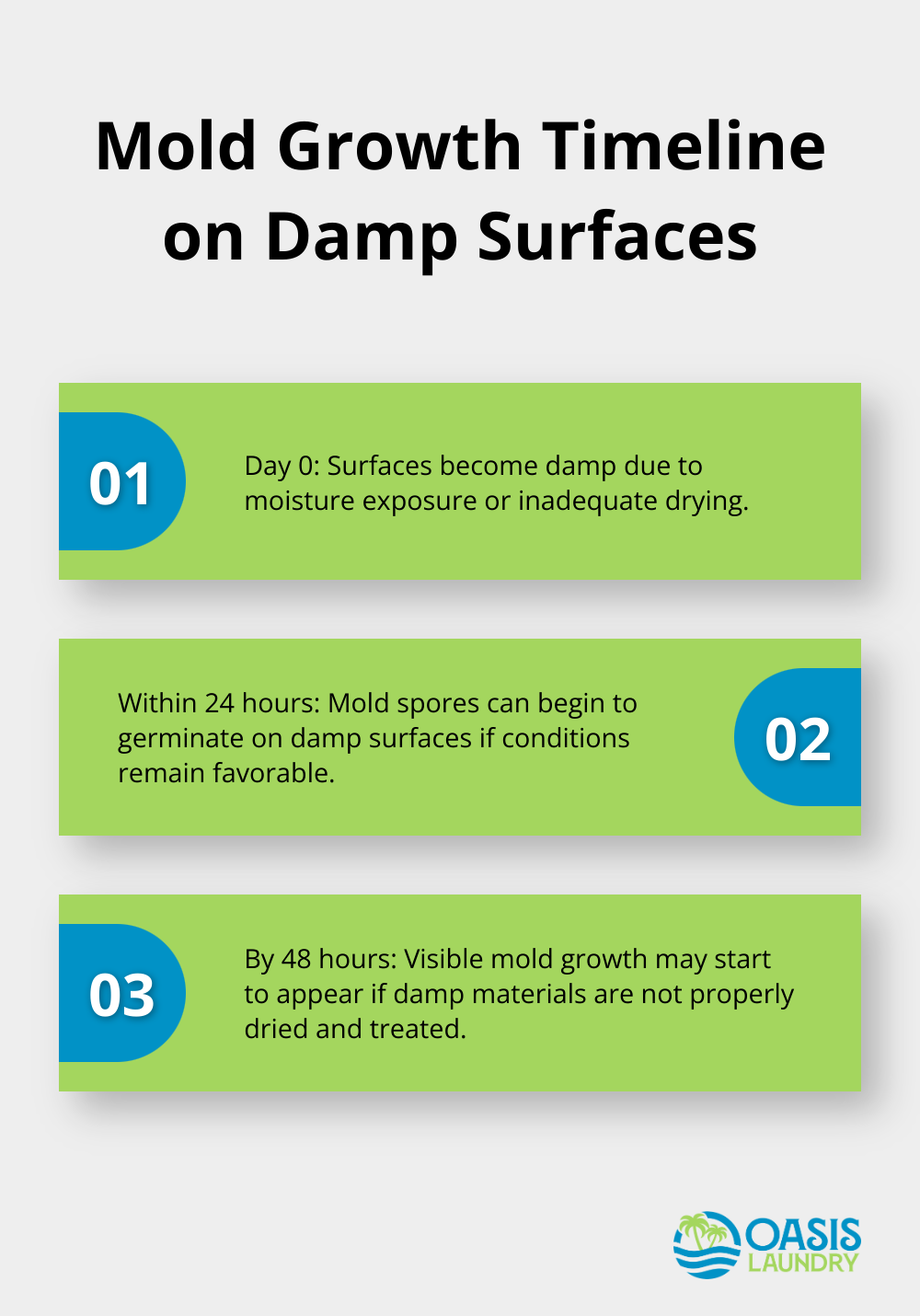
Temperature also plays a significant role. Mold thrives in warm environments between 77°F and 86°F (25°C to 30°C). This explains why summer months often see a spike in mold-related issues.
Fabrics Most at Risk
Natural fibers like cotton, linen, and wool face higher susceptibility to mold growth. These materials absorb moisture more readily than synthetic fabrics. A study published in Sustainable Microbiology evaluated textile susceptibility to fungal contamination during transit by examining growth patterns, onset times, and determining minimum fungal contamination levels.
Synthetic fabrics aren’t immune, though. Polyester and nylon can still harbor mold, especially if left damp for extended periods.
Health Implications of Moldy Textiles
The health risks associated with moldy fabrics prove significant. Inhaling mold spores can trigger allergic reactions, respiratory issues, and in severe cases, infections. The Centers for Disease Control and Prevention reports that exposure to mold can cause symptoms such as nasal stuffiness, eye irritation, wheezing, and skin irritation.
Individuals with pre-existing respiratory conditions or weakened immune systems face even higher risks.
Prevention: The First Line of Defense
Regular inspection and proper storage of textiles serve as key steps in preventing mold growth and maintaining a healthy environment. Try to keep fabrics dry and well-ventilated (especially in humid areas). Use dehumidifiers in damp spaces and ensure proper air circulation in closets and storage areas.
Early Detection: Spotting the Signs
Identifying mold early can save your fabrics and protect your health. Look out for musty odors, discoloration, or visible spots on your textiles. Don’t ignore these signs – they often indicate the beginning of a mold problem that requires immediate attention.
As we move forward, we’ll explore effective cleaning techniques to rescue fabrics already affected by mold and mildew. These methods will help you salvage your textiles and prevent further damage.
How to Clean Mold-Infested Fabrics
Isolate and Assess
When you face mold-infested fabrics, act quickly. Isolate the moldy items to prevent spore spread. Put on protective gear (gloves, mask, and eye protection) before handling contaminated fabrics. Evaluate the extent of the damage. If mold covers more than 10% of the item’s surface, you should consider professional cleaning or disposal.
Pre-treatment for Heavy Mold
For heavily affected items, start with a gentle brushing outdoors to remove loose mold spores. Use a soft-bristled brush for most fabrics. Take care not to inhale the spores or spread them to other items.
Next, pre-treat the fabric with a vinegar solution. Mix equal parts white vinegar and water in a spray bottle. Saturate the moldy areas and let it sit for 15-20 minutes. The acidity of vinegar helps kill mold spores effectively.
DIY Cleaning Methods
For machine-washable items, use the hottest water setting the fabric can tolerate. Add one cup of white vinegar to the wash cycle along with your regular detergent. The Environmental Protection Agency advises against using bleach, as it may not penetrate porous materials effectively. Instead, they recommend scrubbing mold off hard surfaces with detergent and water, and drying completely.
For delicate fabrics, mix one part hydrogen peroxide with two parts water. Apply this solution to the affected areas with a clean cloth, gently dabbing rather than rubbing. Let it sit for 10 minutes before you rinse thoroughly.
Sunlight acts as a powerful mold deterrent. After washing, dry your items in direct sunlight if possible. UV rays help kill remaining spores and prevent regrowth.
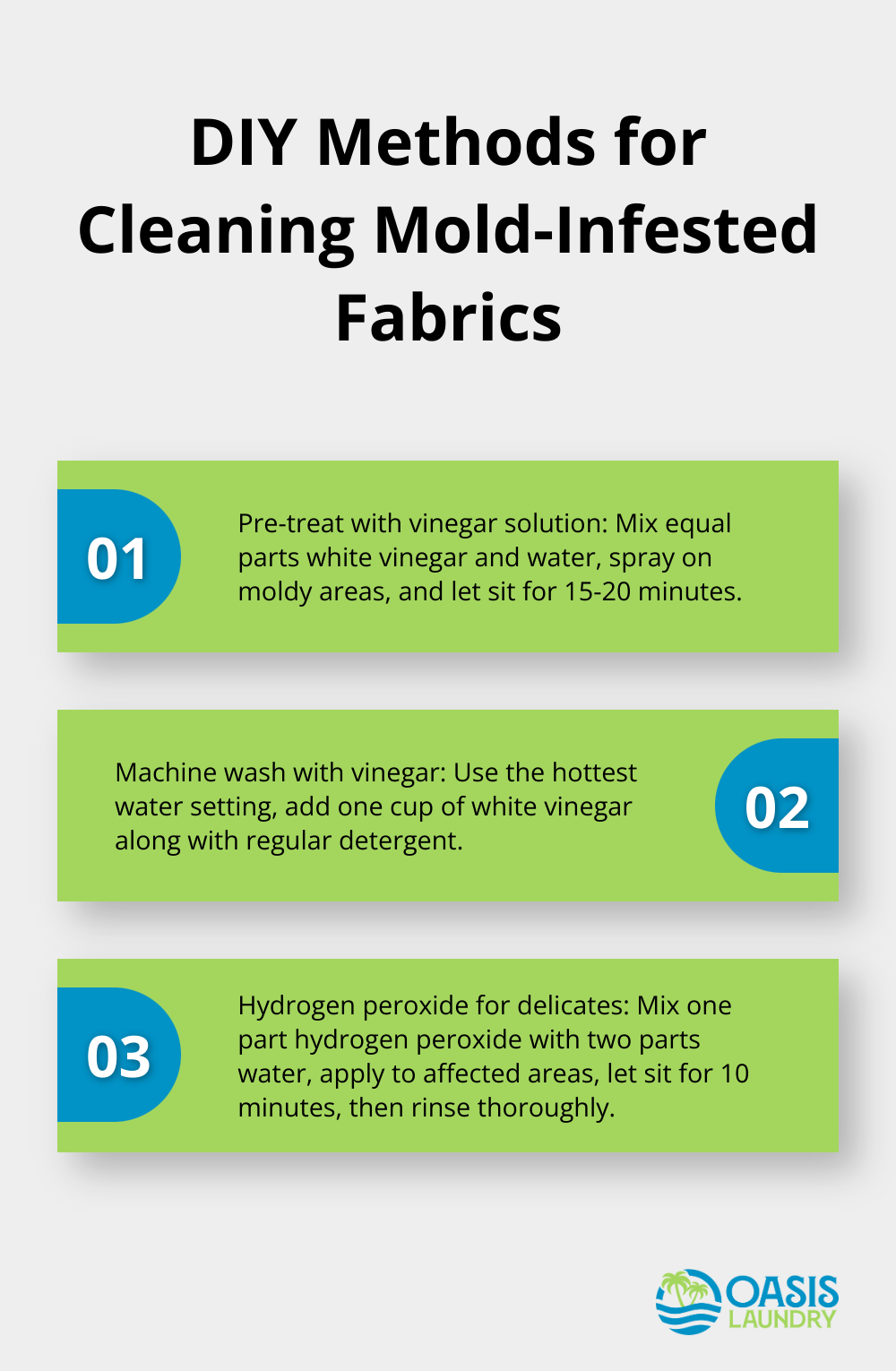
Professional Cleaning Options
For valuable or delicate items, professional cleaning often provides the safest choice. Many professional cleaning services use specialized equipment and eco-friendly cleaning agents to tackle tough mold problems without damaging fabrics.
Dry cleaning can effectively treat certain fabrics. However, inform the cleaner about the mold issue so they can use appropriate techniques and prevent contamination of other items.
Some heavily infested items may be beyond salvage. In these cases, you should dispose of the items to protect your health and prevent mold spread to other belongings.
Moving Forward: Prevention Strategies
Now that you’ve learned how to clean mold-infested fabrics, it’s essential to focus on prevention. The next section will explore effective strategies to keep your textiles mold-free, ensuring you won’t have to face this issue again.
How to Prevent Future Mold Growth
Master Proper Storage Techniques
Store your fabrics in cool, dry places with good air circulation. Avoid damp basements or stuffy closets. Use breathable garment bags for delicate items and add silica gel packets to absorb excess moisture. Relative humidity above 60% can lead to mold growth, so it’s important to keep levels below this threshold.
Clean and dry seasonal clothing completely before storage. Vacuum-sealed bags can help, but use caution with natural fibers as they need some air circulation.
Control Humidity in Your Space
Buy a quality dehumidifier for areas prone to dampness. The EPA suggests you maintain indoor humidity levels between 30-50%. Place moisture absorbers in closets and drawers. These inexpensive products can significantly improve small spaces.
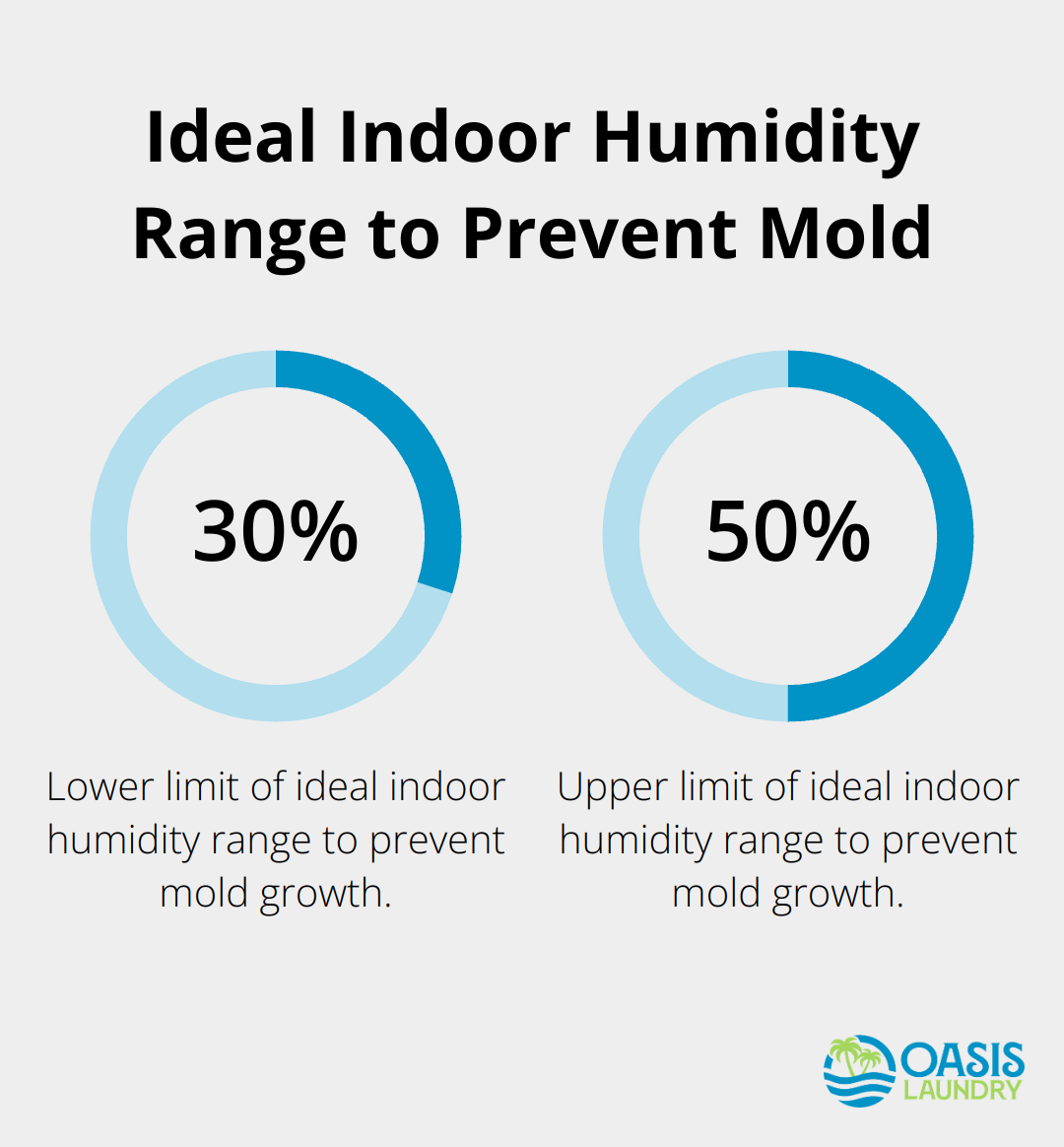
Enhance ventilation throughout your home or business. Use exhaust fans in bathrooms and kitchens. Think about installing a whole-house ventilation system if you live in a particularly humid climate.
Implement Regular Maintenance
Create a routine to inspect and clean your textiles. The National Association of Professional Organizers recommends a quarterly schedule for thorough closet checks. Look for signs of moisture, musty odors, or discoloration.
Clean your washing machine regularly to stop mold growth. Run an empty cycle with vinegar or a specialized cleaner monthly. Always leave the washer door open after use to allow it to dry completely.
Consider Professional Services
For businesses dealing with large quantities of textiles, professional laundering services offer advanced cleaning techniques and eco-friendly products. These services (like those offered by Oasis Laundry) ensure your fabrics remain mold-free and in top condition.
Monitor Problem Areas
Pay extra attention to areas in your home or business that are prone to moisture (such as bathrooms, kitchens, and basements). Address any leaks or water damage promptly. Use mold-resistant products when possible, especially in high-risk areas.
Final Thoughts
Mold and mildew threaten fabrics and health, but you can combat these fungi with the right knowledge and tools. Swift action proves essential when you deal with mold-infested textiles. The longer you wait, the harder it becomes to salvage affected items and stop spore spread.
Proper storage techniques, humidity control, and regular maintenance form the foundation of mold prevention. You will create an environment where mold struggles to grow if you implement these strategies. Professional help should not be overlooked for severe cases or valuable items.
Specialized services offer expert mold remediation techniques that can restore even heavily damaged textiles. Oasis Laundry provides top-notch care while minimizing environmental impact (through eco-friendly approaches). You will keep your textiles fresh, clean, and mold-free for years if you stay vigilant and act quickly when issues arise.


